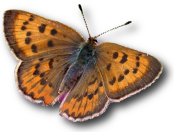 Art Shapiro's Butterfly Site
Art Shapiro's Butterfly Site
Monitoring butterfly populations across Central California for more than 35 years… Brephidium exile
Common Name: (Western) Pygmy Blue

This species demonstrates classic source-sink metapopulation dynamics. West of the Sierra it overwinters successfully only very locally, usually on alkali soils with the favored native host plant Suaeda (Chenopodiaceae) but not subject to flooding. At these sites it breeds all winter, except in the coldest weather. From them it gradually spreads over the entire Central Valley and Bay Area and even into the foothills as the season progresses, breeding on the summer-annual weed Russian Thistle (Salsola, several similar species; the common "Tumbleweed" of our area) along roadsides and railroad rights-of-way. Although these populations may become very dense, they go completely extinct when the plants die off in late autumn. At Suisun this species breeds on Sea Purslane, Sesuvium (Aizoaceae), and can become very abundant but is usually drowned out by winter flooding and has to recolonize the following June (or so).
Larvae are ant-attended and feed largely on flowers and fruit of the host. A generation takes onlyabout 21 days in summer, so population growth can be explosive--but in recent years numbers of this species in our area have been low, which may be related to the fact that the relative abundance of the Salsola species has changed - some seem better hosts than others, though we don't know why. Other hosts used occasionally in our area include Orach (Atriplex patula, A.hastata), Pickleweed (Salicornia, not a frequent host), and the introduced Australian Saltbush, Atriplex semibaccata, formerly common but now extinct in most of our area.
Adults can be found dancing like gnats around the host and perching on it. They wander very far, however, and can turn up in places quite remote from any known hosts. They visit flowers with very shallow corollas, mostly near the ground, but in autumn may swarm over Coyotebrush (especially male plants), as well as Asters and Goldenrods. There is almost no variation except in size, and females may be twice the size of males.
This is an abundant species in alkali lands in the Great Basin, so it should not be surprising that it turns up as a stray on the East slope and in the high country, usually in autumn visitring Rabbitbrush.


